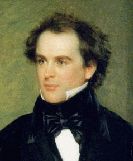Nathaniel Hawthorne
|
|
Missing image Nathaniel_Hawthorne_-_Project_Gutenberg_eText_15161.jpg Nathaniel Hawthorne illustrated in an 1870 publication |
Missing image Nathaniel_Hawthorne_old.jpg Nathaniel Hawthorne in the 1860s |
Nathaniel Hawthorne (July 4, 1804 – May 19, 1864) was a 19th century American novelist and short story writer. He was born in Salem, Massachusetts and died in Plymouth, New Hampshire. Hawthorne's father was a sea captain and descendant of John Hathorne, one of the judges who oversaw the Salem Witch Trials. Hawthorne's father died at sea in 1808, when Hawthorne was only four years old, and Nathaniel was raised secluded from the world by his mother.
Hawthorne attended Bowdoin College in Maine from 1821–1824 where he became friends with Longfellow and future president Franklin Pierce.
In 1842, he married illustrator and transcendentalist Sophia Peabody, and the two moved to the Old Manse in Concord, Massachusetts, where they lived for three years. Their neighbors in Concord included Ralph Waldo Emerson and Henry David Thoreau. Like Hawthorne, Sophia was a reclusive person. She was, in fact, bedridden with headaches until her sister introduced her to Hawthorne, after which her headaches seem to have abated. The Hawthornes enjoyed a long marriage, and Sophia was greatly enamored with her husband's work. In one of her journals, she writes: "I am always so dazzled and bewildered with the richness, the depth, the...jewels of beauty in his productions that I am always looking forward to a second reading where I can ponder and muse and fully take in the miraculous wealth of thoughts" (Jan 14th 1951, Journal of Sophia Hawthorne. Berg Collection NY Public Library).
The two had three children: Una, Julian, and Rose. Una suffered from mental illness and died young. Julian moved out west and wrote a book about his father. Rose converted to Roman Catholicism and took her vows as a Dominican nun. She founded a religious order (http://www.hawthorne-dominicans.org/found.htm) to care for victims of cancer.
Hawthorne died 1864May 19 in Plymouth, N.H. on a trip to the mountains with his friend Franklin Pierce.
Writings
Hawthorne is best-known today for his many short stories (he called them "tales") and his four major romances of 1850–60: The Scarlet Letter (1850), The House of the Seven Gables (1851), The Blithedale Romance (1852), and The Marble Faun (1860). (Another book-length romance, Fanshawe, was published anonymously in 1828.)
Before publishing his first collection of tales in 1837, Hawthorne wrote scores of short stories and sketches, publishing them anonymously or pseudonymously in periodicals such as The New-England Magazine and The United States Democratic Review. Only after collecting a number of his short stories into the two-volume Twice-Told Tales in 1837 did Hawthorne begin to attach his name to his works.
Much of Hawthorne's work is set in colonial New England, and many of his short stories have been read as moral allegories influenced by his Puritan background. "Ethan Brand" (1850) tells the story of a lime-burner who sets off to find the Unpardonable Sin, and in doing so, commits it. One of Hawthorne's most famous tales, "The Birth-Mark" (1843), concerns a young doctor who removes a birthmark from his wife's face, an operation which kills her. Other well-known tales include "Rappaccini's Daughter" (1844), "My Kinsman, Major Molineux" (1832), "The Minister's Black Veil" (1836), and "Young Goodman Brown" (1835). "The Maypole of Merrymount" recounts a most interesting encounter between the Puritans and the forces of anarchy and hedonism.
Recent criticism has focused on Hawthorne's narrative voice, treating it as a self-conscious rhetorical construction, not to be conflated with Hawthorne's own voice. Such an approach complicates the long-dominant tradition of regarding Hawthorne as a gloomy, guilt-ridden moralist.
Hawthorne enjoyed a brief friendship with American novelist Herman Melville beginning on August 5 1850, when the two authors met at a picnic hosted by a mutual friend. Melville had just read Hawthorne's short story collection Mosses from an Old Manse, which Melville later praised in a famous review, "Hawthorne and His Mosses." Melville's letters to Hawthorne provide insight into the composition of Moby-Dick. Hawthorne's letters to Melville did not survive.
Edgar Allan Poe wrote important, though largely unflattering reviews of both Twice-Told Tales and Mosses from an Old Manse.
External links
- Eric Eldred's excellent Hawthorne site (http://www.eldritchpress.org/nh/hawthorne.html) at Eldritch Press contains all of Hawthorne's works, notes on the writings, annotated editions,and lots of other information.
- The Hawthorne in Salem Website (http://www.hawthorneinsalem.org) was funded in May of 2000 by a three-year grant from the National Endowment for the Humanities and is a collaborative effort of North Shore Community College in Danvers, Massachusetts, and three Salem, Massachusetts museums with important Hawthorne collections.
- Herman Melville's appreciation, "Hawthorne and His Mosses" (http://209.11.144.65/eldritchpress/nh/hahm.html) (1850)
- Henry James's important book-length study, Hawthorne (http://209.11.144.65/eldritchpress/nh/nhhj1.html) (1879)
bg:Натаниел Хоторн da:Nathaniel Hawthorne de:Nathaniel Hawthorne eo:Nathaniel HAWTHORNE fr:Nathaniel Hawthorne it:Nathaniel Hawthorne ja:ナサニエル・ホーソーン

